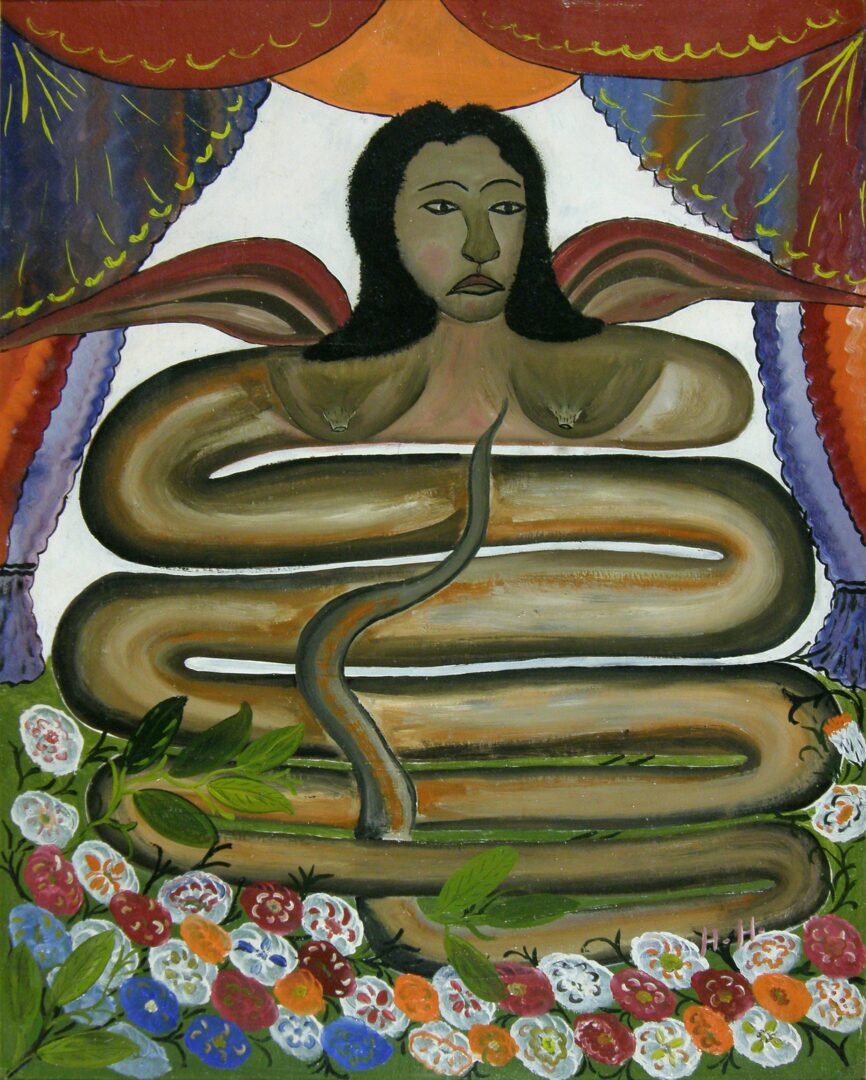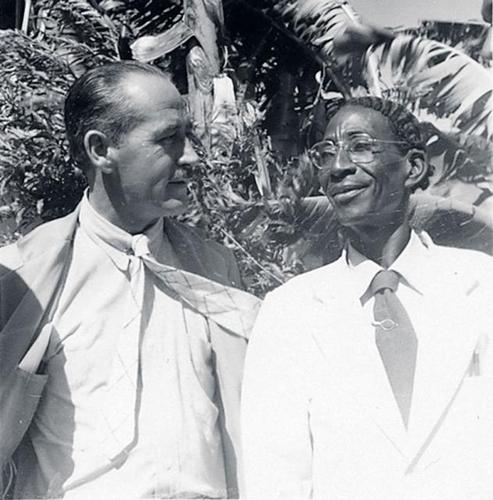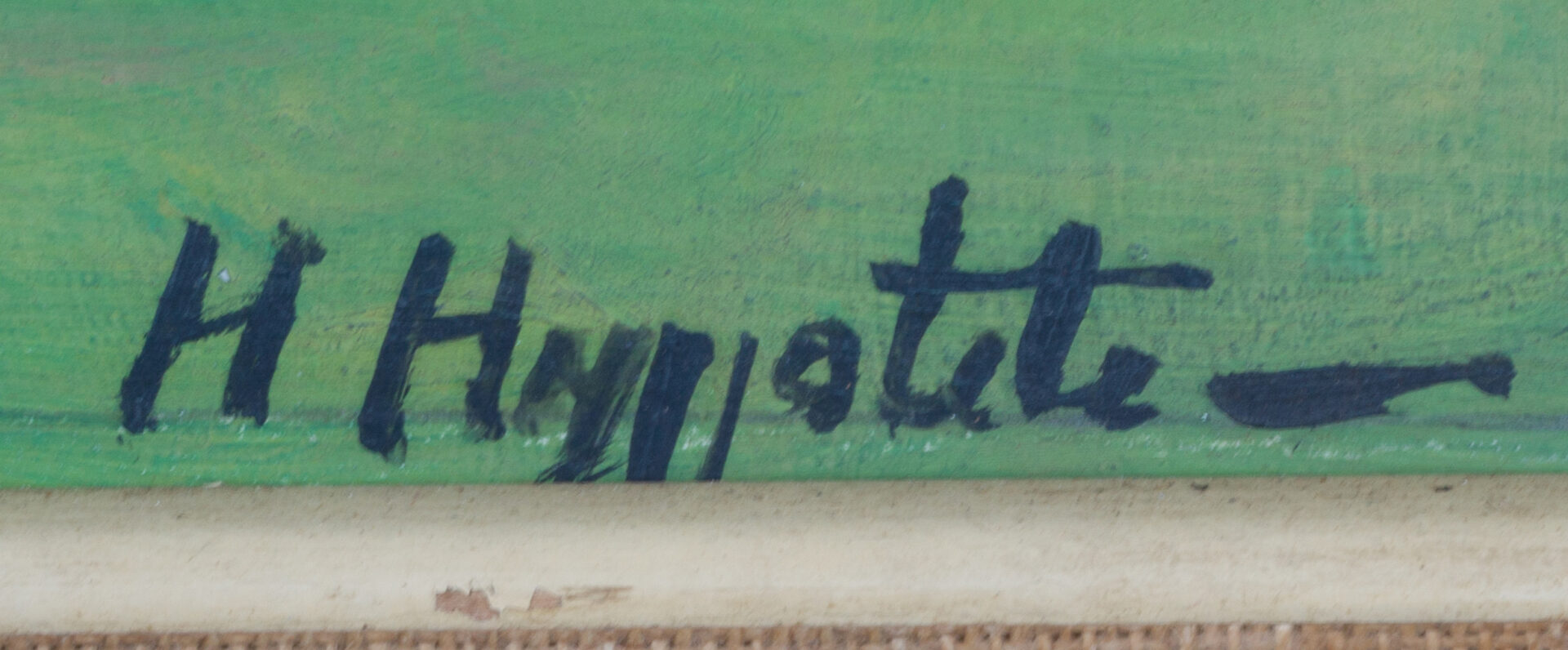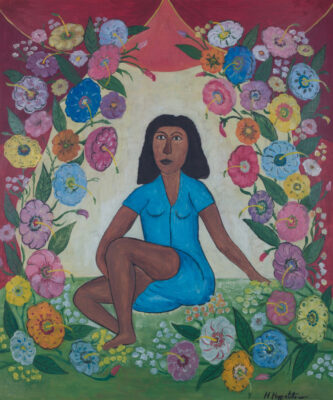Hector Hyppolite: The Visionary Who Brought Vodou to Canvas

Hector Hyppolite – the self-taught Haitian Vodou painter whose visionary works enchanted the Surrealists – returns to the spotlight with a rare piece featured in Aurora & Athena’s November 8 auction.
Table of Contents
Hector Hyppolite – Haiti’s self-taught Vodou painter whose vivid imagination put Caribbean art on the map – is capturing collectors’ attention once again. Aurora & Athena’s November 8, 2025 Fine Art Auction (auroraathena.com) features one of Hector Hyppolite’s paintings, shining a spotlight on this folk art master’s legacy. Famed for his bright Vodou-inspired paintings, Hyppolite rose from humble origins to global renown, and his work now stands as a cornerstone of Haitian art history.
This article delves into his colorful life story, the spiritual and cultural themes of his art, and why Hector Hyppolite’s auction prices have been climbing in recent years – all in anticipation of the rare opportunity to acquire a Hyppolite masterpiece at the upcoming sale.
Biography & Mythos of Hector Hyppolite
Born in 1894 in the coastal town of Saint-Marc, Hector Hyppolite had no formal art training yet became one of Haiti’s most legendary painters. Before he ever touched canvas, Hyppolite lived many lives: he was a cobbler and house painter, and notably a Vodou houngan (priest) serving his community.
According to lore, the artist claimed that spirits guided his hand when he finally began painting in his late 40s – using chicken feathers and cheap house paints in lieu of proper art supplies. Indeed, Hyppolite’s first “brushes” were made from chicken feathers, and he painted on surfaces like cardboard or discarded boards, fueled by visions he attributed to the Vodou loa (spirits).
Hyppolite’s life is steeped in myth. He often told grand tales of his experiences, at one point even claiming to have traveled across Africa in his youth (a claim historians view as self-made legend rather than fact (en.wikipedia.org)). Far more central to his identity was his spiritual life: as a third-generation Vodou priest, Hyppolite believed the divine was ever-present. He reportedly considered La Sirène, the sea goddess of Vodou, to be his spiritual wife (gallevery.com) – a testament to how deeply intertwined his faith was with his art.
This charismatic blend of faith and folklore made Hyppolite a visionary figure. In Haiti, stories spread of the painter entering trance-like states as he worked, “transforming divine visions and local folklore into visual stories” on his canvases. His late start in fine art (around 1943-1945) did nothing to impede his prolific output – in roughly three years he created between 200 and 600 paintings, though fewer than half survive today (gallevery.com). At the height of his fame, new paintings by Hyppolite were reportedly celebrated with street parades in Port-au-Prince – as if heralding the arrival of a national treasure (gallevery.com).
Though his career was brief (he died in 1948 at age 54), the mythos of Hector Hyppolite continues to grow, immortalizing him as a kind of folk hero of Haitian art.
Artistic Style & Themes in Hyppolite’s Paintings
Hector Hyppolite’s paintings are immediately recognizable for their naïve style and spiritual energy. As a self-taught artist unbound by academic rules, Hyppolite developed a bright, intuitive aesthetic that merges childlike simplicity with profound symbolism. His brushwork (often literally feather-work) is direct and raw, applying bold colors in flattened perspectives. Figures and forms are outlined in rhythmic strokes, giving his compositions a sense of movement and mystical vibration.
What might seem “naïve” in technique is sophisticated in storytelling: every painting is dense with imagery drawn from Vodou religion, Haitian folklore, and daily life.

Common themes in Hector Hyppolite’s paintings include Vodou loa (spirit deities), biblical or historical scenes reimagined in Haitian settings, lush tropical flora and fauna, and everyday people imbued with divine significance.
For example, Hyppolite’s famed work Maîtresse Erzulie depicts the Vodou goddess of love as a beautiful woman surrounded by flowers and symbols, marrying Haitian spiritual iconography with a vibrant decorative style.
In another celebrated piece, Ogou Ferraille (the warrior spirit) is portrayed riding a horse, clad in military attire, reflecting how Haitian Vodou spirits often syncretize with Catholic saints or local heroes.
Hyppolite’s The Congo Queen (La Reine Congo) conflates a Vodou goddess with the Virgin Mary, showcasing his deft blending of African, European, and Caribbean influences (gallevery.com). Across his body of work, tropical birds, angels, mermaids, and serpents populate the scenes – motifs like serpents often representing Dambalah (the serpent spirit) or Erzulie’s snakes, and mermaids referencing La Sirène. His palette is joyous and unrestrained: jungles of emerald green, skies of saturated blue, and halos of orange and red give his paintings a dreamlike, celebratory tone.
Despite his association with French Surrealists (more on that below), Hyppolite’s imagery was not born of European theory but of Haitian spirituality. He painted what he knew and believed – yet by sheer coincidence, his intuitive depictions of spirits, dreams, and fantastical creatures resonated strongly with surrealist ideas. André Breton described Haitian art (Hyppolite’s in particular) as having the power to “drink the blood of the phoenix” and renew the world (news.artnet.com), a florid way to acknowledge its originality.
In truth, Hyppolite’s art stands apart: sacred and sincere, with a stylistic directness that channels Haiti’s cultural soul. Today, collectors prize these paintings not only for their vivid beauty but for the window they offer into a uniquely Haitian cosmos of symbols and stories.
Cultural Impact and Legacy
Hyppolite’s rise coincided with a broader artistic blossoming often called the Haitian Art Renaissance of the mid-20th century.
In 1944, American teacher DeWitt Peters founded Le Centre d’Art in Port-au-Prince as a space to encourage local artists – and Hyppolite soon became its star discovery (en.wikipedia.org).
Despite living in a rural town, Hyppolite’s talent was championed by Haitian writers like Philippe Thoby-Marcelin, who brought him to the capital in 1946 (en.wikipedia.org).
At the Centre d’Art, Hyppolite finally had access to proper paints and canvases (though he still famously stuck to his house paint and feather brushes at times).

His subject matter also shifted subtly: recognizing that foreign buyers were intrigued by Vodou, he infused more overt Vodou symbolism into his art during this perioden.wikipedia.org. The result was a powerful fusion of Haitian folk tradition with a modern artistic vision – something that felt entirely new on the global art scene.
The international art world took notice quickly. In late 1945, Surrealist leader André Breton visited Haiti. Upon encountering Hyppolite’s paintings (Breton purchased five on the spot), he was entranced, heralding Hyppolite as a living embodiment of surrealist ideals (en.wikipedia.org). Breton wasn’t alone – Cuban artist Wifredo Lam also acquired works, and soon Haitian paintings were being whisked to New York and Paris. In 1947, Hector Hyppolite’s art represented Haiti at a UNESCO exhibition in Paris, earning enthusiastic acclaim (en.wikipedia.org).
That same year in Paris, Breton co-organized the landmark show Le Surréalisme en 1947, which featured Hyppolite’s work among surrealist masters (gallevery.com). Hyppolite, the humble houngan from Saint-Marc, had become an international sensation almost overnight.
Museums and collectors raced to acquire his creations. The Museum of Modern Art in New York famously obtained Hyppolite’s La Reine Congo (The Congo Queen) by 1946 (gallevery.com), making it one of the first Haitian paintings in a major international museum. (MoMA’s curator René d’Harnoncourt had been an early advocate for Haitian art (news.artnet.com).) Over the decades, Hyppolite’s works have entered numerous prestigious collections worldwide – from the Milwaukee Art Museum’s Haitian Collection to the National Gallery of Art in Washington.
Exhibitions devoted to Haitian art almost invariably feature Hyppolite as a centerpiece, underscoring his status as Haiti’s most famous painter. Contemporary Haitian artists often cite Hyppolite as a spiritual forefather, and his influence can be seen in the colorful, symbolic style of later painters like Préfète Duffaut and André Pierre.
Crucially, Hyppolite’s legacy also shifted perceptions of what “high art” could be. As an intuitive artist from a small Caribbean nation, he challenged the art establishment’s biases. Critics and poets (from Truman Capote to André Malraux) who encountered his canvases in the 1940s were stunned by their authenticity – “there’s nothing in it that has been slyly transposed,” Capote remarked in praise (en.wikipedia.org).
Hyppolite proved that Haitian folk art deserved as much admiration as European modernism. Today, with Haitian art gaining fresh international spotlight (news.artnet.com), Hyppolite’s spirit looms large. Major exhibitions in 2024/25, such as Spirit & Strength: Modern Art from Haiti (National Gallery of Art) and Surrealism and Us (Fort Worth Modern), celebrate Hyppolite alongside other Haitian masters (news.artnet.com) – a testament to how enduring and globally resonant his vision remains.
Hector Hyppolite’s Market Value & Collectibility
For decades after his passing, most Hector Hyppolite paintings resided in museums or personal collections, seldom appearing on the market. In recent years, however, there’s been a surge of interest in Haitian art, and Hector Hyppolite’s auction prices have climbed dramatically. Though his works were once relatively affordable, today they are recognized as blue-chip items of Caribbean art. In fact, since 2020, no fewer than nine Hyppolite paintings have exceeded $100,000 at auction, reflecting a sharp reevaluation by collectors (news.artnet.com).
His current auction record was set in 2022, when a circa-1947 painting titled Damballah La Flambeau (depicting the serpent spirit Ayida Wedo) sold for $365,400 at Christie’s New York (news.artnet.com). This result stunned many, soaring past its $250,000 high estimate (news.artnet.com) and underscoring Hyppolite’s newfound status in the global art market.
What is driving this upswing? One factor is scarcity. Hyppolite’s output was limited to a few hundred works, of which far fewer are circulating; many remain tucked away in Haitian families or in institutions. Each authentic Hyppolite that surfaces is thus a rare treasure. Additionally, there is a growing appreciation for artists outside the Euro-American canon. Collectors of visionary and “Outsider” art see Hyppolite as a pioneering figure – the Haitian parallel to Frida Kahlo or Henri Rousseau – whose art is both culturally specific and universally compelling.
The provenance and stories behind his pieces also add cachet: a painting acquired by André Breton in the 40s, or one exhibited in a famous show, will naturally ignite bidder excitement.
Even with the recent spike, experts note that Haitian masters like Hyppolite remain undervalued relative to their art-historical importance (news.artnet.com). Gallery specialists and collectors have remarked that these works present strong value, especially as Haitian art steadily gains international recognition (news.artnet.com). In practical terms, that means a Hyppolite painting can be acquired for a fraction of the price of a European modernist painting of similar vintage and quality – a tantalizing prospect for shrewd buyers.
The flip side is that as more collectors realize this, competition (and prices) will likely continue to rise. For art enthusiasts interested in both cultural significance and investment potential, Hyppolite’s work ticks both boxes. There is an emotional satisfaction in owning a piece that not only enlivens a wall with tropical colors but also carries the spiritual legacy of Haiti in its pigments.
November 8 Auction Highlight: Woman’s Figure by Hector Hyppolite
At Aurora & Athena’s upcoming November 8, 2025 Fine Art Auction (auroraathena.com), one of the crown jewels is Lot 7: “Woman’s Figure” by Hector Hyppolite. This painting, an oil on board measuring 60 × 49 cm, encapsulates the mystical essence of Hyppolite’s art. The composition presents a graceful female figure emerging from a field of ochre, blue, and green hues.
Outlined in confident, sinuous strokes, her form almost shimmers – as if Hyppolite painted not just a woman, but an emanation of a loa.
The atmosphere is devotional and enigmatic: the ordinary is made divine, inviting the viewer into a dreamlike encounter. In Woman’s Figure, Hyppolite’s characteristic elements shine through – sacred intuition and human feeling merging on the canvas.
The woman’s eyes are introspective, her pose frontal and iconic, calling to mind images of Erzulie or perhaps the Virgin Mary, yet she belongs purely to Hyppolite’s universe.
Painted likely in the mid-1940s, Woman’s Figure exemplifies Hyppolite’s instinctive use of color and composition.
The surface is tactile, bearing the marks of his improvised tools and technique – you can almost imagine the artist using a chicken feather to outline her silhouette. The background is alive with abstract foliage and rhythmic patterns, a nod to Haiti’s lush nature and Vodou cosmology.
Despite its modest size, the work has a commanding presence, radiating what Aurora & Athena’s specialists describe as “spiritual energy” and a sense of mystery beyond the visible. It’s a piece that bridges Haitian folk tradition with a modernist eye for form: both symbolic and sensual in equal measure.

Importantly for collectors, Woman’s Figure comes to auction with attractive credentials.
It has been held in a private collection in France, indicating a storied provenance that often appeals to buyers of historical art.
The painting is in good vintage condition (framed and with only minor wear, as noted in the condition report). Aurora & Athena has set an estimate of €8,000–€10,000 for this lot, reflecting both the artwork’s rarity and the auction house’s confidence in the market.
Given recent trends, this estimate appears enticingly accessible – a fact likely not lost on keen bidders. Woman’s Figure is not just an artwork for sale; it’s a rare chance to acquire an original Hector Hyppolite. Opportunities to purchase Hyppolite are scarce, especially a work that so thoroughly distills his iconic style. Whether you are a seasoned collector of Caribbean art or a new admirer of Haitian painting, this lot represents a special moment.
Aurora & Athena’s Commitment to Diverse Masterpieces
Aurora & Athena Auction House has a growing reputation for spotlighting important artists from around the globe, and the inclusion of Hector Hyppolite in the November sale underscores that mission. In recent auctions, Aurora & Athena has championed artists beyond the traditional Euro-American canon – from African modernists to Asian avant-gardists – recognizing the richness of the world’s art heritage. Haitian art by Hector Hyppolite now joins that narrative.
Woman’s Figure will be the first work by a Haitian master to be offered by Aurora & Athena, marking a proud milestone. “We are thrilled to bring a piece of Haiti’s art history to auction,” says the house’s specialist team, noting that Hyppolite’s art carries “the soul of a culture” in its pigments.
This offering follows Aurora & Athena’s broader commitment to intuitive and self-taught artists. (Earlier this year, for instance, the house successfully placed works by other self-taught visionaries in private collections, paving the way for Hyppolite’s debut on their roster.)
By presenting Hyppolite alongside European, American, and Asian artworks in the November 8, 2025 Fine Art Auction Aurora & Athena highlights a “dialogue across continents and visions,” as the auction title suggests. The house recognizes that collectors today have ever-expanding tastes: a 20th-century Haitian Vodou painting can share the spotlight with, say, mid-century abstract art or Impressionist landscapes – each offering its own lens on the human experience.
For readers who have been following Aurora & Athena’s journal, this moment ties into ongoing conversations about the globalization of the art market. Just as our July 2025 Auction saw enthusiastic response to Latin American and African diaspora artworks, this November we anticipate vigorous interest in Hyppolite’s painting.
The auction house’s leadership notes that educating collectors is part of the process: through articles like this and our pre-sale exhibitions in Barcelona, we aim to honor the context behind the canvas. Hector Hyppolite’s art, born of Haiti’s syncretic culture and the artist’s raw talent, is exactly the kind of meaningful artwork Aurora & Athena is proud to champion.
Conclusion: A Visionary’s Legacy Lives On
Hector Hyppolite’s paintings carry the soul of Haiti – mystical, joyful, and unbridled. Though created in the 1940s by a man who painted from his humble courtyard under the spell of spirits, these works have a timeless resonance. They speak of a world where everyday life and the sacred coexist, where a simple folk painting can channel universal themes of faith, love, and resilience. In celebrating Hyppolite, we also celebrate Haiti’s rich artistic heritage and its contribution to global art history.
As Aurora & Athena showcases Woman’s Figure on November 8, 2025, both collectors and art lovers are invited to experience the magic of Hyppolite’s vision firsthand. It’s a chance to stand before a painting that is much more than pigment on board – it’s a cultural artifact, a spiritual portrait, and a testament to the power of untutored genius. The upcoming auction puts a spotlight on this Haitian master, affirming that his vivid Vodou visions still shine brightly on the world stage. Don’t miss the opportunity to be a part of Hector Hyppolite’s enduring legacy – whether by acquiring a masterpiece or simply by reveling in the story of a remarkable artist whose light refuses to dim.
